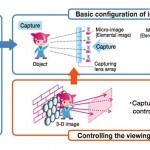NHK Integral 3D
... Integral 3D, in short, is one of the most astonishing display technologies we've ever seen, even in its presently embryonic state. Instead of stereoscopic screens that use shutter glasses to direct alternate images into each eye, NHK's integral display uses thousands of microlenses to reconstruct a spatial 3D image filmed from multiple angles — the upshot is that you're able to adjust your perspective on the subject based on your position. For example, in a demonstration video of a baseball game, we were able to see offscreen fielders simply by tilting our head a few inches to the side, and footage of a sumo bout allowed for greater comprehension of the wrestlers' grapples and movement. It solves the problem of viewing angles on traditional 3DTVs, and transforms the experience of watching TV into something more involved.
Right now, the main drawback is the resolution. NHK's current integral 3D prototype actually employs Super Hi-Vision technology, but that's because each effective onscreen pixel requires hundreds more to render the multiple perspectives. As such, the image currently appears very grainy even on a screen of around 30 inches. While this could eventually be solved by a finer array of microlenses, each lens would then require more pixels in order to add the appropriate depth perspective. For now, integral displays aren't much more than a tantalizing glimpse into the far-off future — NHK doesn't expect the technology to be commercialized until around 2030.
See the original post here;
